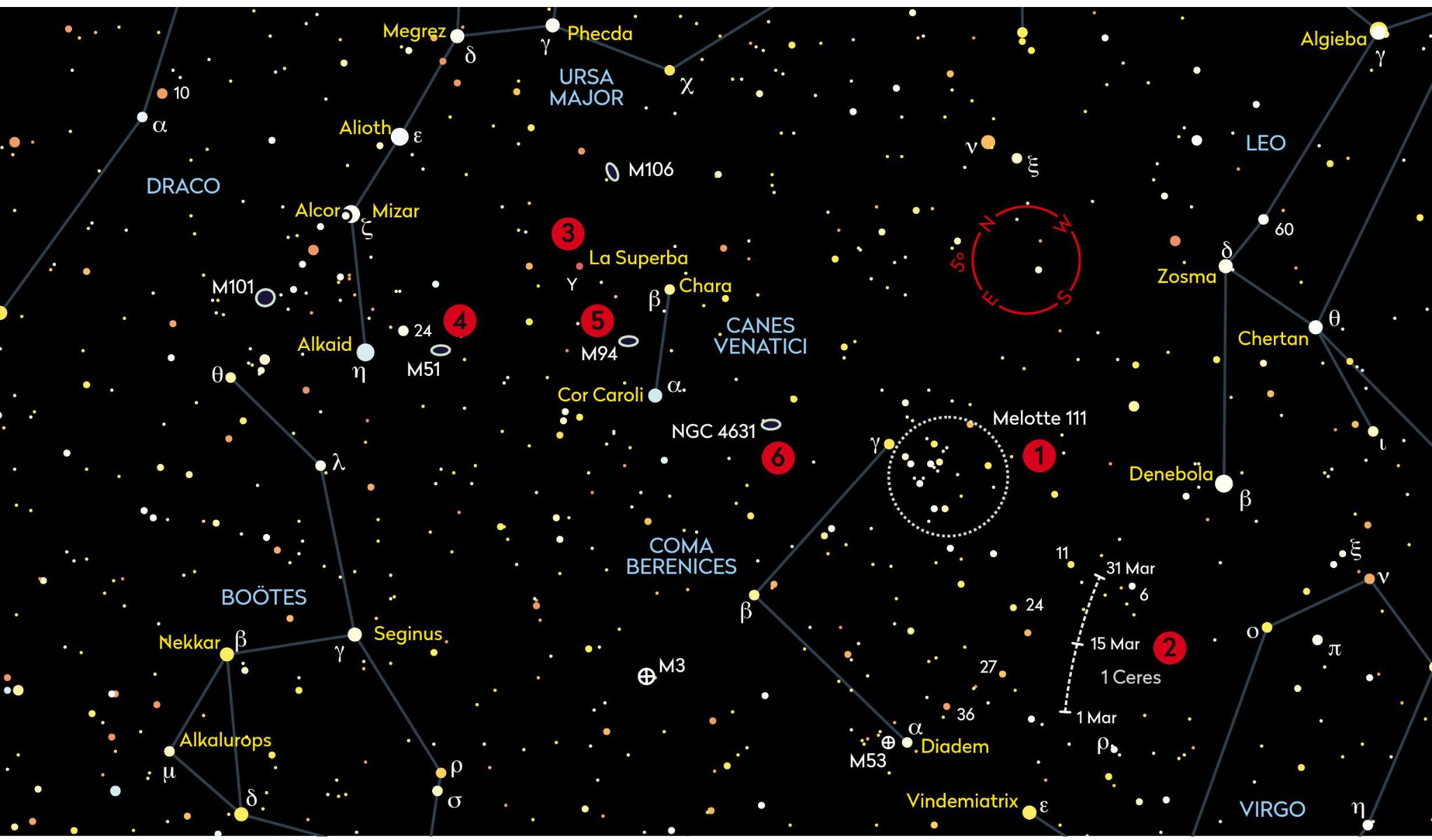This month we’re prowling for targets with the hunting dogs, Canes Venatici

1. Melotte 111
Recommended equipment: 10×50
The Coma Berenices Cluster, Melotte 111, is one of the finest celestial sights for binoculars, extending for nearly 6° and filling the view of 10×50 binoculars. You can see it with your naked eye as a misty patch between mag. +2.9 Cor Caroli (Alpha (α) Canum Venaticorum) and mag. +2.1 Denebola (Beta (β) Leonis). Look for the inverted ‘V’ of the cluster’s brighter stars, with mag. +4.3 Gamma (γ) Comae Berenices at its apex.
2. Ceres
Recommended equipment: 10×50
Ceres is the only dwarf planet that is visible in binoculars. At the beginning of the month, you will find it a little more than 3° north of mag. +4.9 Rho (ρ) Virginis, shining at mag. +7.4. It moves westward through the northern part of the Virgo–Coma cluster of galaxies, reaching a peak magnitude of +7.1 at opposition (when it is directly opposite the Sun) on 21 March, then declining to mag. +7.2 by the month’s end.
3. La Superba
Recommended equipment: 10×50
Locate mag. +4.2 Chara (Beta (β) Canum Venaticorum) and pan 4.5° towards mag. +2.2 Mizar (Zeta (ζ) Ursae Majoris) where there lies a distinctive red-orange star (it looks a deeper orange in larger apertures). This is Y CVn, a cool carbon star whose magnitude varies from +6.3 to +4.7, with a period of about 160 days. The name La Superba refers to its spectrum, not its visual appearance.
4. The Whirlpool Galaxy, M51
Recommended equipment: 10×50
Our first galaxy is very easy to find and, because of its high surface brightness, is also quite easy to see. Imagine that a line from Mizar to mag. +1.9 Alkaid (Eta (η) Ursae Majoris) is the stem of an upper case letter ‘L’. M51 lies at the end of the foot of this imaginary ‘L’, 3.5° from Alkaid. If you use averted vision, can you detect that the glow of these 100 billion suns is slightly elongated?
5. M94
Recommended equipment: 15×70
Imagine a line joining Cor Caroli to Chara, and from halfway along this line go 2° in the direction of Alkaid. Here, possibly needing averted vision until you learn to recognise it, you’ll find the 23-million-year-old light from the spiral galaxy M94. Like all galaxies, it benefits greatly from dark, transparent skies, but it is usually quite easy to see once it rises above any low-level skyglow.
6. The Whale Galaxy, NGC 4631
Recommended equipment: 15×70
Our final target has no nearby markers to help locate it, but it’s very close to the middle of a line joining Cor Caroli to Gamma Comae. It’s a bit fainter than our other two galaxies, making it a bit of a challenge in 70mm binoculars, so you may need averted vision. What you will see is an east–west streak of light, but probably not the slight distortion that gives it its common name.